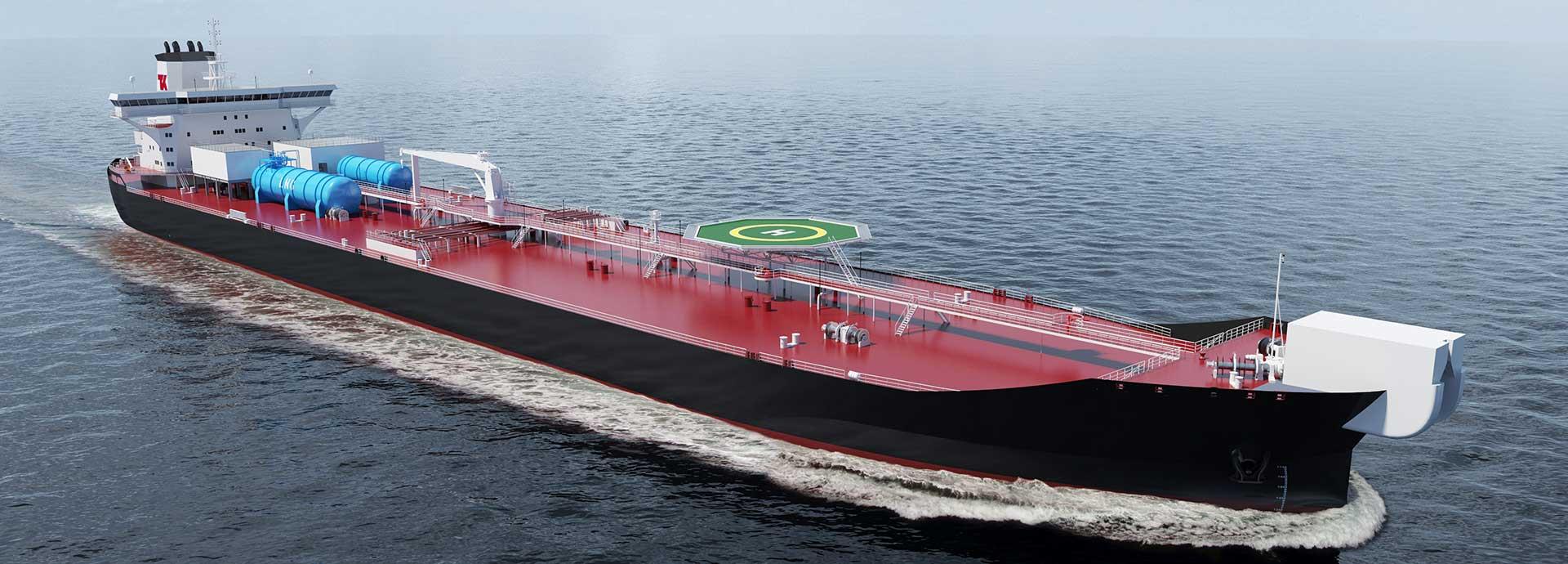

A new shuttle tanker concept developed by TEEKAY, in cooperation with Wärtsilä, using Wärtsilä’s marine solutions expertise is setting new benchmarks for emission-control and efficiency.
The winds of change are blowing for the shuttle tanker sector. This is thanks to a new, innovative concept jointly developed by the world’s largest shuttle tanker provider, TEEKAY, and Wärtsilä.
“Compared with a conventional shuttle tanker, this new concept will eliminate Volatile Organic Compound (VOC) emissions from cargo. While the NOx from the engine exhaust will be reduced by 84%, which is well below IMO Tier 3 levels, the SOx emissions will be practically eliminated, and finally the particles will be reduced by more than 96%, thus resulting in an astonishing reduction of emissions,” explains Stein Thorsager, Sales Director, Wärtsilä Marine Solutions.
TEEKAY, which has already placed four orders for this new shuttle tanker, is one among many shipping companies betting on this concept to weather the future. The key attraction for many of them is the new, innovative, overall fuel efficiency concept with electric propulsion and dual-fuel generating sets. Wärtsilä’s VOC recovery plant is also an important environmental aspect to ship owners and charters.
A multi-tasking VOC recovery plant
For the uninitiated, a shuttle tanker is a vessel that is used to transport oil from offshore fields to onshore land terminals. A conventional shuttle tanker releases large amounts of VOC into the atmosphere during loading and transportation of crude oil. Studies estimate that about 3300 tons is released into the atmosphere, yearly, for every offshore loading in the transport of crude oil. These need to be captured by VOC recovery plants to reduce emissions.
Wärtsilä has designed a futuristic take on the VOC recovery plant that will prepare shuttle tankers to meet further emission regulations expected in 2030.
“The Wärtsilä VOC recovery plant uses compression and cooling phases to liquefy the heavier hydrocarbons to Liquid VOC (LVOC) that is stored in a tank on the deck of the vessel. The lighter hydrocarbons that are not liquefied, which mainly comprise methane gas, will be burnt in a gas turbine for electricity generation, chosen because of the two times better efficiency than the traditional use of boiler with steam generator,” explains Thorsager.
It doesn’t end there. Wärtsilä and TEEKAY’s new shuttle tanker design also allows the LVOC to be used as fuel for the tanker. By replacing the traditional two-stroke propulsion engine with four-stroke dual-fuel engines for electric propulsion system, Wärtsilä developed the possibility to mix LNG and LVOC and use this mixture as fuel for the engine.
“So far, the LVOC was considered a waste product. After the engines were changed from two-stroke to four-stroke, we developed and tested the possibility of mixing LNG with LVOC in gas form as potential valuable fuel for our engine. TEEKAY can now use 100% of the recovered LVOC as fuel for electric power generation where LVOC is mixed into LNG at a mixing rate of up to 30% LVOC,” says Thorsager.
Reliable power distribution
TEEKAY’s major requirement from Wärtsilä for the new shuttle tanker was also a reliable power distribution for the vessel.
The tanker uses Wärtsilä’s low loss hybrid systems (LLH) to help reduce fuel consumption and increase savings and overall system efficiency. The LLH power distribution model also limits the impact of a failure during dynamic positioning of a vessel. The LLH will only lose 25% of its power and one thruster as compared with conventional power systems that lose 50% of the installed power and several thrusters.
The installed batteries will handle the dynamic load variations and hence give the engines a stable load. Therefore, they can operate in a higher load area without risking the start-up of additional generators due to transient load variations. This shuttle tanker is the first ship of this size using batteries for improving efficiency during transit operation.
More orders in the pipeline
“The new shuttle tanker concept is now seeing interest from various shipping companies across the world,” says Thorsager.
Speaking of what TEEKAY’s orders did for Wärtsilä, Thorsager says “it created an acceptance and recognition of Wärtsilä by both customers and builders as a reliable provider of complete systems and services.” This, he believes, reflects Wärtsilä’s role as a truly lifecycle service provider rather than an equipment provider.
“We have a large product portfolio and by integrating products together we are building systems and providing added value to the customer. We are also reducing the risk for the builder since Wärtsilä is taking the overall functional responsibility of the systems. So, owners will now have fewer vendors to follow up with to ensure that their vessels are performing and operating in accordance with expectations. With the digital offering such as online real time ship monitoring system, Wärtsilä has a powerful after sales offering to any ship owner,” he says.
Wärtsilä has also signed contracts with Malaysian-owned AET for two shuttle tankers with a different engine configuration, but with the same VOC recovery systems on board. Thorsager foresees new vessels with Wärtsilä’s VOC installations navigating the Norwegian part of the North Sea in the coming years. In addition to new business which will demand new vessels, he also sees new vessels emerging as a consequence of the renewal program of existing fleets.
Did you like this? Subscribe to Insights updates!
Once every six weeks, you will get the top picks – the latest and the greatest pieces – from this Insights channel by email.

